Real Boxes...but
not “Cigar Boxes”
A National Cigar Museum Explanation
© Tony Hyman

Real Boxes...but
not “Cigar Boxes”
A National Cigar Museum Explanation
© Tony Hyman
Boxes in this exhibit aren’t frauds, fakes or fantasies. They’re real and old, but they’re not cigar BOXES. A cigar BOX is a retail package in which cigars are packed at the factory, in which they are transported to a retailer or customer, and from which they are sold. These are something different.
Who cares what kind of box it is?
Collectors care...and collectors are the people who buy boxes. That means that sellers, dealers and auctioneers should care.
Selling price (and profit) is dependent on reaching the correct buyer. Cigar box collectors don’t care about the humidors, cigarette boxes, candy boxes, or pyrographic boxes you’ll be introduced to here. And the people who want those things don’t care about retail cigar boxes. So, if you incorrectly identify what you have, especially in your listing title on ebay (what most bidders search on) potential buyers won’t see your item.
If you were selling a hammer, you wouldn’t call it a washing machine. A dog is not a cat.
California fruit & candy boxes
A genuine redwood box, but no ID, no Caution Notice, no tax Class notice and no tax stamp should alert you that it’s not a cigar box. These attractive boxes were used by MISSION PACK and other 1920-1980 mail-order packer-producer-shippers of stuffed and candied California dates and fruits.
They can be found in a variety of sizes and shapes usually with California scenes: beaches, redwoods, lakes, mountains, Missions or date palms.
Cigarros boxes
These fancy boxes say “Cigarros” but that means cigarettes in Cuban. They are cigarette boxes designed to sit atop a man’s desk or front-room coffee-table. The size of the compartment is the give-away, too small for even the standard 4” to 4½” cigar of 1900.
The ashtray is missing on the bottom box.
Cigarros is perhaps the single most often mistranslated word by gringoes. In fact, it was mistranslated so often, since the mid 1900’s the word has taken on the mistranslated meaning. On cards, boxes and packages before WWI it correctly means cigarettes. [11703] [11704]
How do you tell if your box is a retail cigar box?
With its polished wood, interlocked corners, strong hinges, sure catches, and inside collar to help seal the box, this LA CORONA looks like a humidor, and could be used as one, but it’s a retail cigar box.
The proof is on the bottom. Boxes have 12 sides, but only the bottom is regulated by law and required to be true. Various legal information is found on the bottom of retail cigar boxes, and no other containers.
[1] All cigar BOXES from 1868 to 1962 have an ID identifying the factory, tax district and quantity. The ID says 100 of these cigars were made in Factory No. 1 in Customs District 11 (that is American Tobacco located in Trenton, NJ).
[2] The rectangular Caution Notice which is on a paper label until 1910 and printed on the bottom thereafter.
[3] The Tax Class indicating the cigars cost 20¢ or more each and were in tax Class E, the price-class combination from 1919 to 1942, dating the box to that period.
[4] The remnants of a Bonded stamp which guarantees the cigars were made in the United States entirely of Cuban tobacco. Older stamps like this also describe the process by which they were made.
A box that has any one of these 4 legal requirements is a retail cigar box. That’s why the bottom is the first place I look when I find any box. Canadian boxes have similar info but other foreign boxes do not, unless they were imported into the U.S. before 1960.
Can a box be a cigar box AND a humidor?
A few boxes were designed to be reused for various purposes once the initially packed cigars were all smoked. But, as can be seen in one NCM exhibit, they were seldom reused as a humidor. This appears to be because Federal law prohibited reusing boxes for cigars again and, though this law was intended to prevent tax stamp fraud, it was interpreted literally by many people involved in the industry. That long-standing prohibition against reuse has been rewritten and reinterpreted in the modern day. Many retail boxes are now sold with the intention they be reused as humidors.
Humidors
These boxes say “Cigars” right on the top.
That makes them cigar boxes. Right?
Technically, no. They’re properly called
cigar humidors.
What’s the difference? They weren’t sold full of cigars. Cigar HUMIDORS are boxes sold empty in cigar stores, men’s shops and elsewhere and designed for the purpose of storing cigars in the home in a manner that keeps them fresh and smokable. Older ones are frequently made of oak, often decorated with fancy nickel plated trim. A principle difference is inside the box. HUMIDORS are typically lined in zinc and have a way to add moisture to the contents.
Oak boxes like those at right embellished with “Cigars” are humidors, typically dating 1880 to 1920. They originally sold between $2 and $6 and were frequently given away as premiums.
Some humidors are fancier than others inside. To the right is a particularly nice interior. [11085]
The lovely celluloid-covered humidor below uses the same stock “Cigars” as seen on the oak humidor to the right of it. [10444] [11084]
Top right is not in the NCM collection.



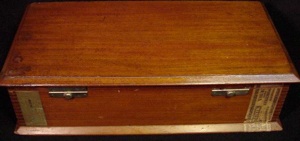
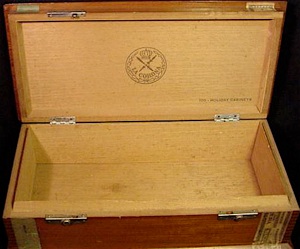


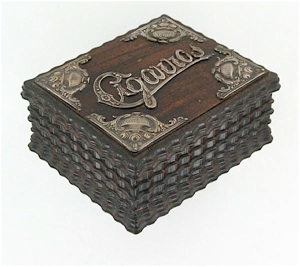

![Pyrographic (wood burning) boxes

These brown-patterned boxes are often called “cigar boxes.” They are often shaped like cigar boxes but only very rarely held cigars.
Made of soft light-colored wood between 1900 and 1960 these overall-patterned boxes were sold in 10¢ stores (are you old enough to remember them?) and hobby shops for less than a buck. They were intended to be used as patterns by pyrographers, people whose hobby was creating and embellishing designs on wood using a wood-burning tool much like a sharp tipped soldering iron. Wood-burning was still a popular Cub Scout activity in the 1940’s.
Generations of pre-teen boys and girls got their first wood burning kits as Christmas presents. Kits came with a variety of tips to make different widths and styles of dot, line and chisel mark, so we could embellish these boxes with our own artistic flair.
I’ve handled hundreds of these pyrography boxes and discovered two that WERE used as cigar boxes including the top box pictured here. The factory, wholesaler or retailer responsible for choosing that style packing gave his customers a welcome reusable bonus.
How do you know if your pyrographic box is a cigar box? The same way you know if ANY box is a cigar box: it has an ID (usually steam-pressed into the wood on the bottom). More on IDs is <here>.
The pictured hinge is typical, often broken from the wood or with missing nails. They are marked “Wizard” and “F. Grammes & Sons, Allentown, PA.”
-----------
TOP TO BOTTOM:
• Pyrographic cigar box used by Pamperin & Wiggenhorn
Cigar Co., Fact. 132, 2nd Dist., La Crosse, WI, c1905;
[11087]
• Hinge typical of nearly all pyrographic boxes. [12687]
• Florals are the most common patterns. [12689]
• Finished box, ready to use or give as a gift. [12690]](Boxes_not_cigar_files/shapeimage_2.png)


Cigarette boxes of the Russian silversmiths
These finely crafted small (4.25” x 3.25” x 2.5”) cigar box-shaped cigarette boxes were made in shops of the world-renown Russian silversmiths in the second half of the 19th century. The boxes were modeled after 19th century Cuban cigar brands popular among the Russian wealthy, and contain fine detail, right down to the Russian tax stamp. I’ve seen three different brands, and wouldn’t be surprised to learn more exist.
Rare and expensive in sterling, they were also made in brass. I’ve seen four on ebay, all selling for less than a fifth of the $1500 I paid for this one 25 years ago. Bargains all, but they’re not cigar boxes.
[11702]
Silver and silver-plated boxes
[11706] [11712]



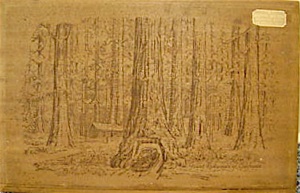

Pop-culture cardboard creations
Cadillacs and Dinosaurs is based on a clever graphic novel called Xenozoic Tales by Mark Schultz produced in the late 1980’s which I enjoyed enough to buy the box when it came up on ebay. I’m not sure what, if anything, it held.
Similar cigar-box-like creations honor (or rip-off) other pop-culture graphics, cartoon characters, TV shows, bands, etc., and usually held candy.
Since they are all made after the era of ID’s, tax classes, and caution notices, you’re on your own when it comes to dating. They are usually very short lived, so this is one of the few times when a registration or patent date will be within a year or two of the actual year it was produced. 11094]
Modern “stash box”
Continuing in that vein...This box is seen with some regularity on ebay. It can best be described as a modern “stash box” designed to hold smoking tobacco, cigars, or other smokable substances.
It is strictly a gag item, not old, not a cigar item, of limited interest to decorators and of no interest to collectors. A police-chief friend who has no respect for the IQ
of most criminals assures me it’s the first place his men would look in a raid.
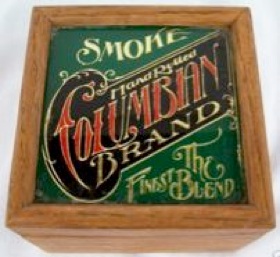

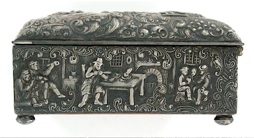
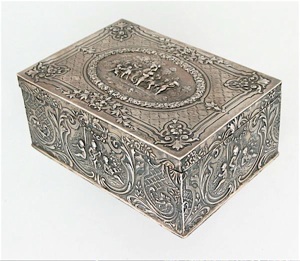
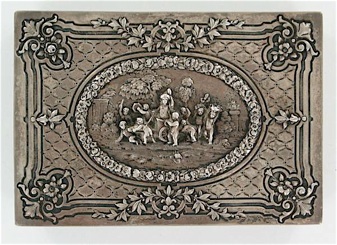
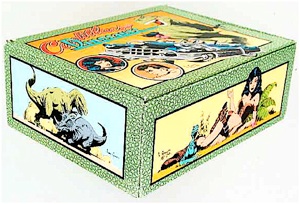
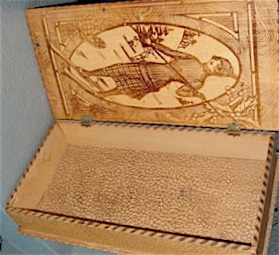
• Pyrographic box incorrectly described as cigar box on ebay.